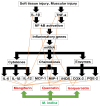Phytochemical, antioxidant, antipyretic and anti-inflammatory activities of aqueous-methanolic leaf extract of Mangifera indica
- PMID: 37560231
- PMCID: PMC10408527
Phytochemical, antioxidant, antipyretic and anti-inflammatory activities of aqueous-methanolic leaf extract of Mangifera indica
Abstract
Objective: Plant-based natural antioxidants have a wide variety of biological activities with significant therapeutic value. Mangifera indica has been used traditionally to treat a variety of ailments in animals and human, but little is defined about its biological or pharmacological effects. Therefore, the objective of the present study was to evaluate phytochemical, antioxidant, antipyretic and anti-inflammatory activities of aqueous-methanolic leaf extract of M. indica.
Methods: To investigate the possible impact of aqueous-methanolic leaf extract of M. indica on oxidative stress, inflammation, and pyrexia, we used a combined in vitro and in vivo series of experiments on laboratory animals.
Results: Results revealed significant antioxidant potential in 2,2-diphenylpicrylhydrazyl (DPPH) and nitric oxide (NO) scavenging assay, while significant but dose dependent antipyretic potential was documented in typhoid-paratyphoid A and B (TAB) vaccine and prostaglandin E (PGE) induced pyrexia models. Significant anti-inflammatory effects were observed in both acute and chronic inflammatory models of arachidonic acid and formalin. Phytochemical screening and high-performance liquid chromatography (HPLC) analysis of M. Indica confirmed the presence of mangiferin, quercetin, and isoquercetin. These phytoconstituents likely play a role in the observed biological activities. Our results show that M. indica has antioxidant, anti-inflammatory, and antipyretic effects, lending credence to its traditional use and advocating for its utilization as a viable contender in treating oxidative stress-associated ailments.
Conclusion: It is concluded that Magnifera indica has various properties in the treatment of various diseases.
Keywords: Inflammation; Mangifera indica; antioxidant; prostaglandins; pyrexia.
AJTR Copyright © 2023.
Conflict of interest statement
None.
Figures








References
-
- Khan IA, Aziz A, Manzoor Z, Munawar SH, Sarwar HS, Afzal A, Raza MA. Study on antipyretic activity of Rumex vesicarius leaves extract in albino rabbits. Vet World. 2014;7:44–48.
-
- Shinwari ZK. Medicinal plants research in Pakistan. J Med Plant Res. 2010;4:161–76.
-
- Saeed M, Muhammad N, Khan H. Assessment of heavy metal content of branded Pakistani herbal products. Tropical J Pharm Res. 2011;10:499–506.
-
- Saeed M, Muhammad N, Khan H, Khan SA. Analysis of toxic heavy metals in branded Pakistani herbal products. J Chem Soc Pak. 2010;32:471.
LinkOut - more resources
Full Text Sources
